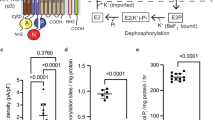Abstract.
Living cells require membranes and membrane transporters for the maintenance of life. After decades of biochemical scrutiny, the structures and molecular mechanisms by which membrane transporters catalyze transmembrane solute movements are beginning to be understood. The plasma membrane proton-translocating adenosine triphosphatase (ATPase) is an archetype of the P-type ATPase family of membrane transporters, which are important in a wide variety of cellular processes. The H+-ATPase has been crystallized and its structure determined to a resolution of 8 Å in the membrane plane. When considered together with the large body of biochemical information that has been accumulated for this transporter, and for enzymes in general, this new structural information is providing tantalizing insights regarding the molecular mechanism of active ion transport catalyzed by this enzyme.
Similar content being viewed by others
Author information
Authors and Affiliations
Additional information
Received 4 November 1999; received after revision 10 January 2000; accepted 13 January 2000
Rights and permissions
About this article
Cite this article
Scarborough, G. The plasma membrane proton-translocating ATPase . CMLS, Cell. Mol. Life Sci. 57, 871–883 (2000). https://doi.org/10.1007/PL00000730
Issue Date:
DOI: https://doi.org/10.1007/PL00000730




